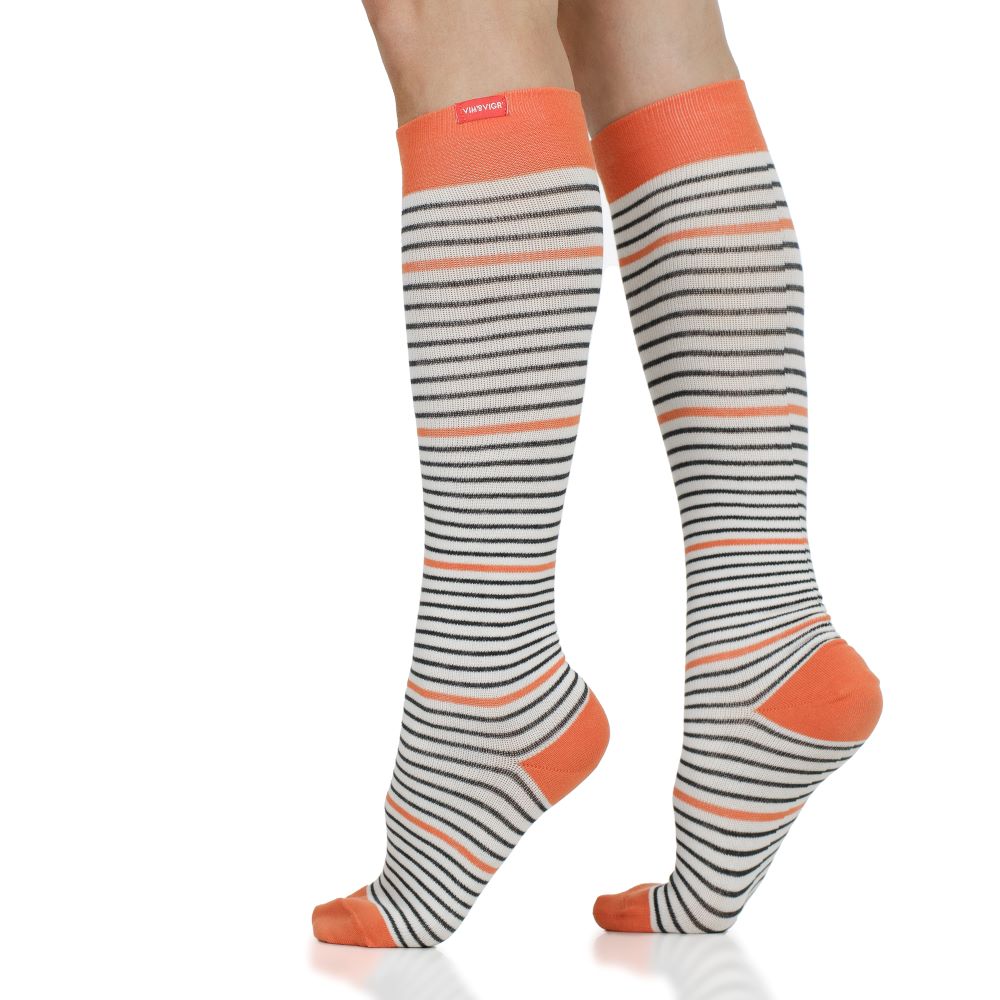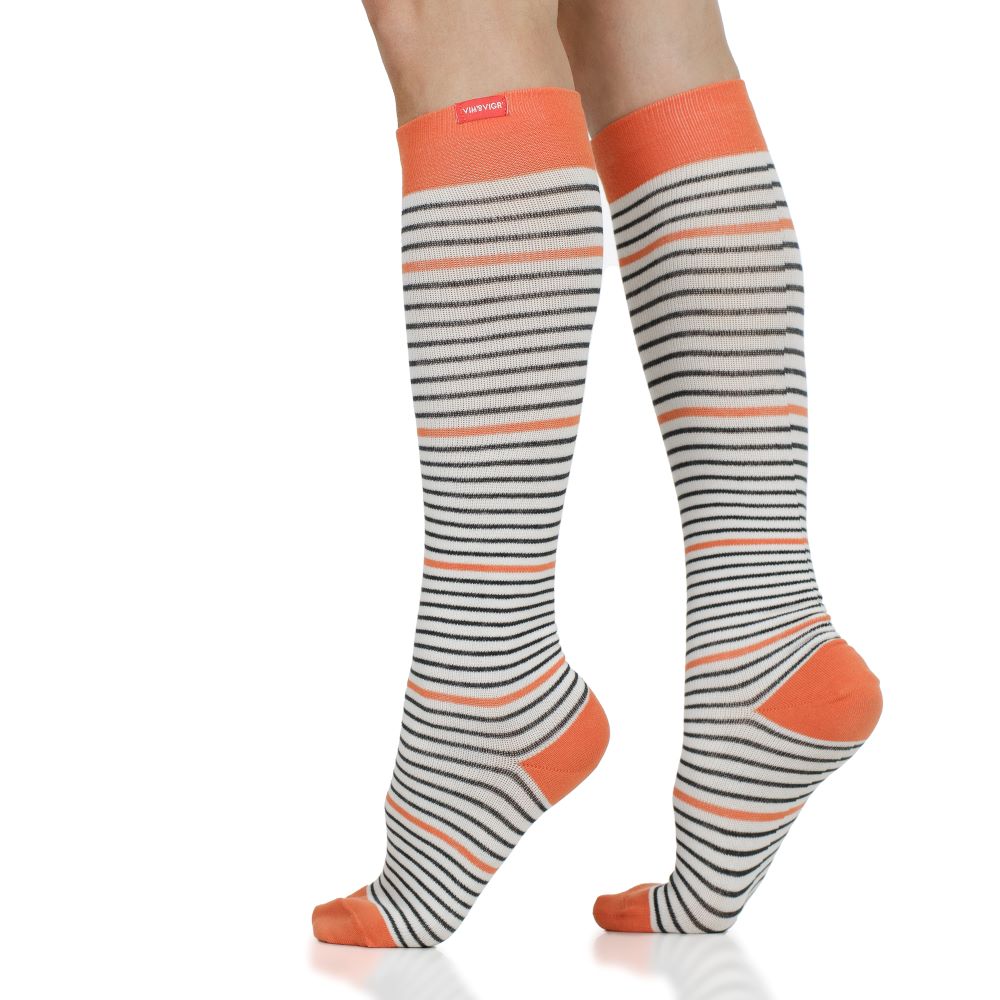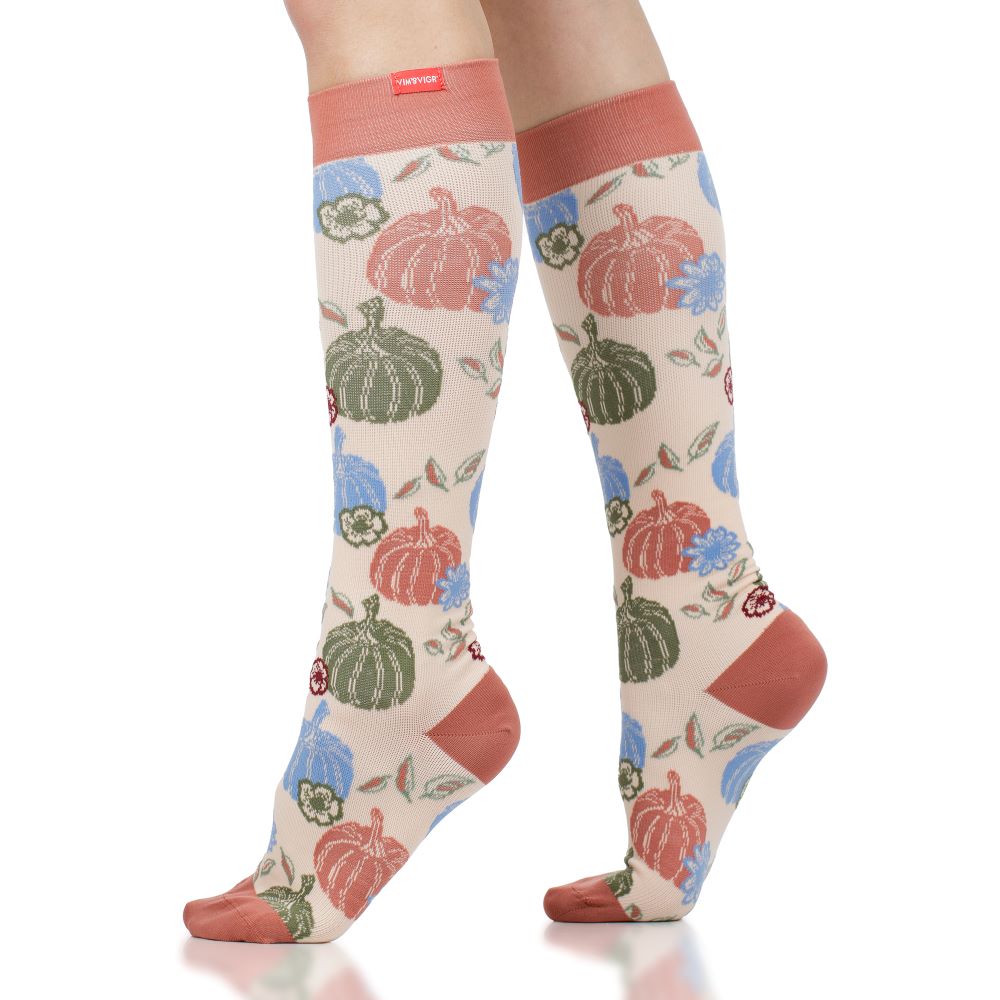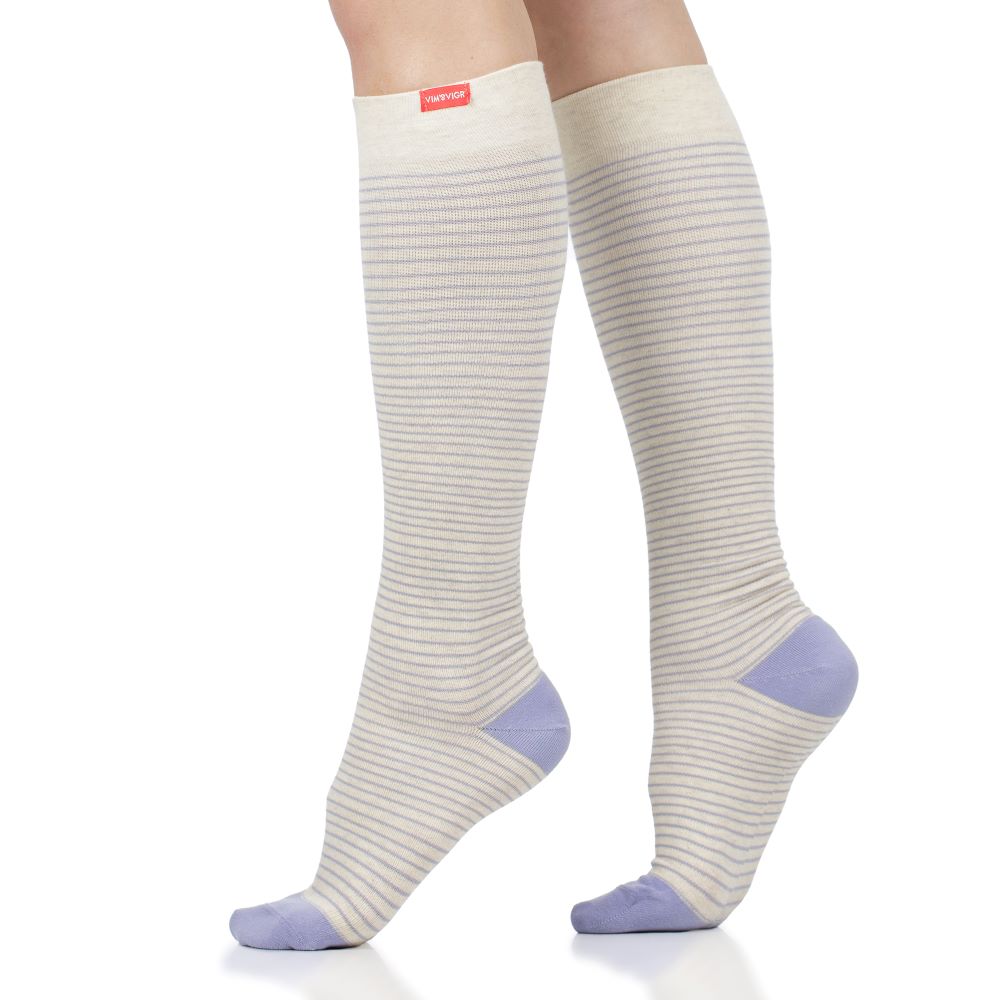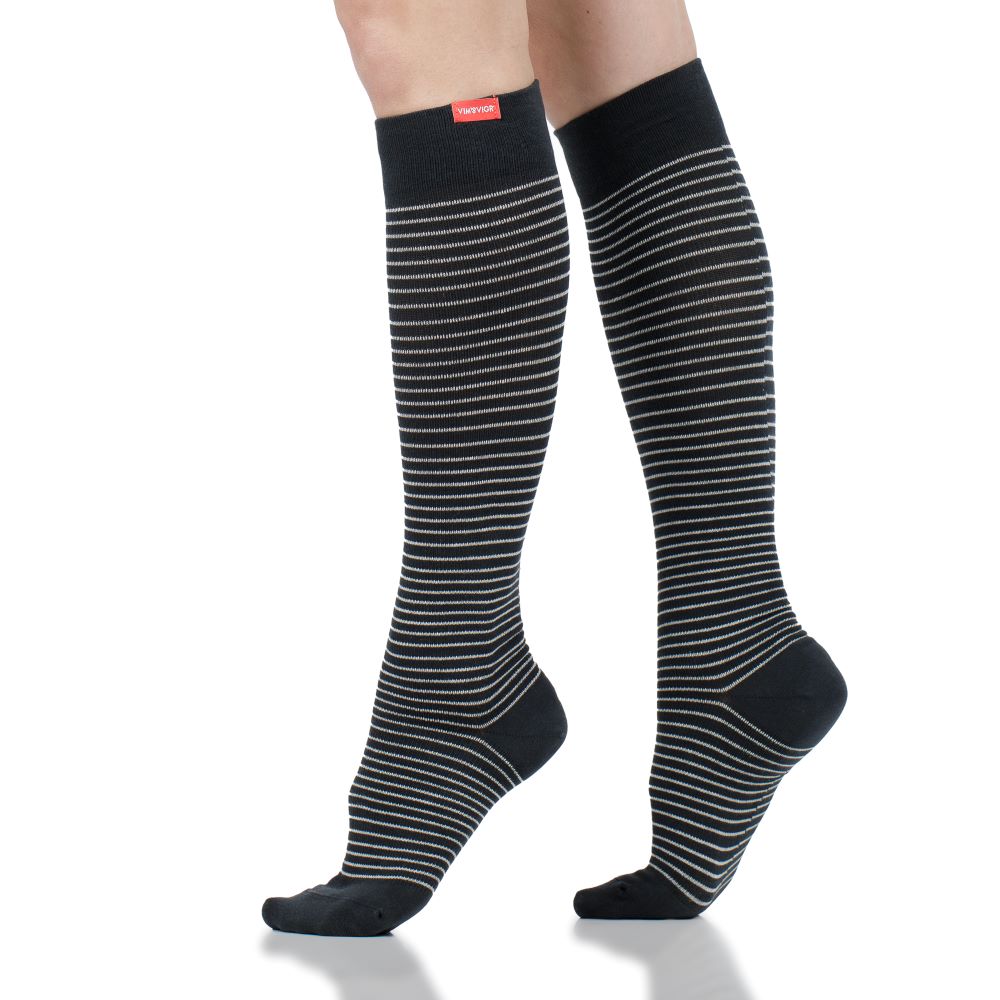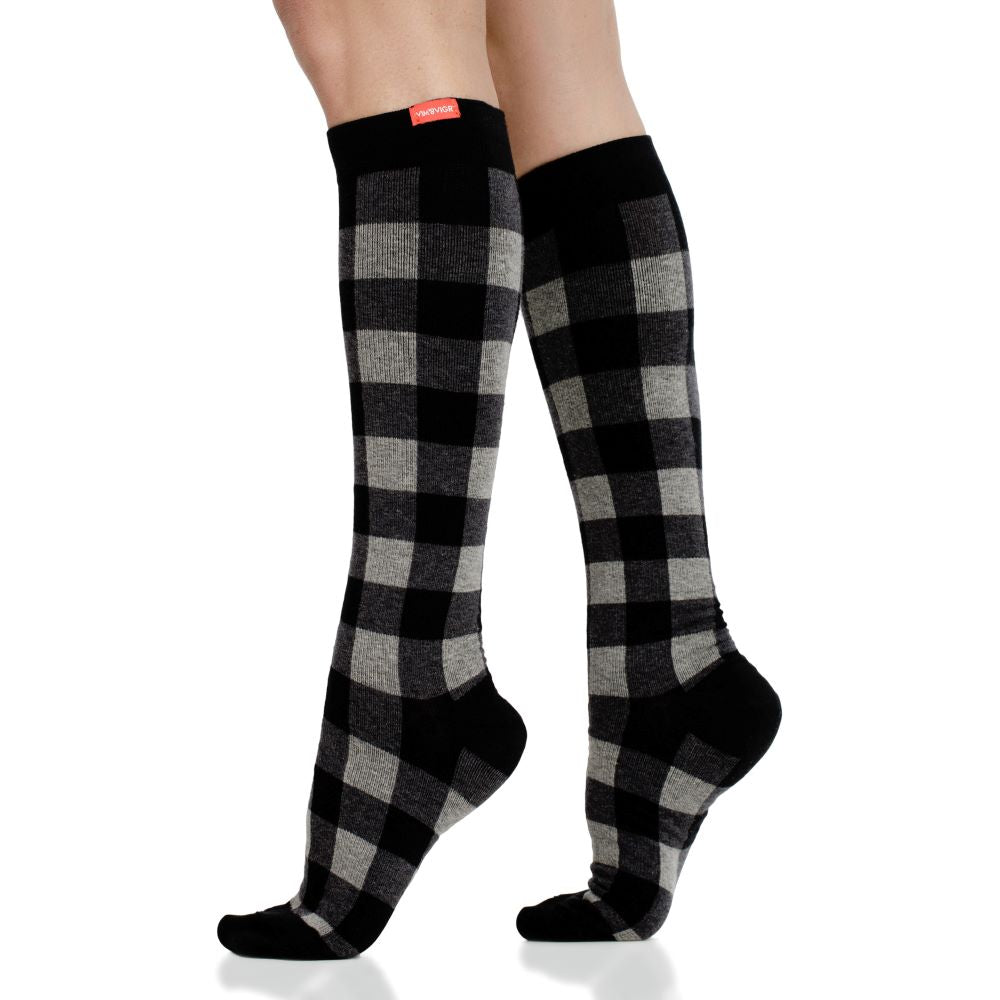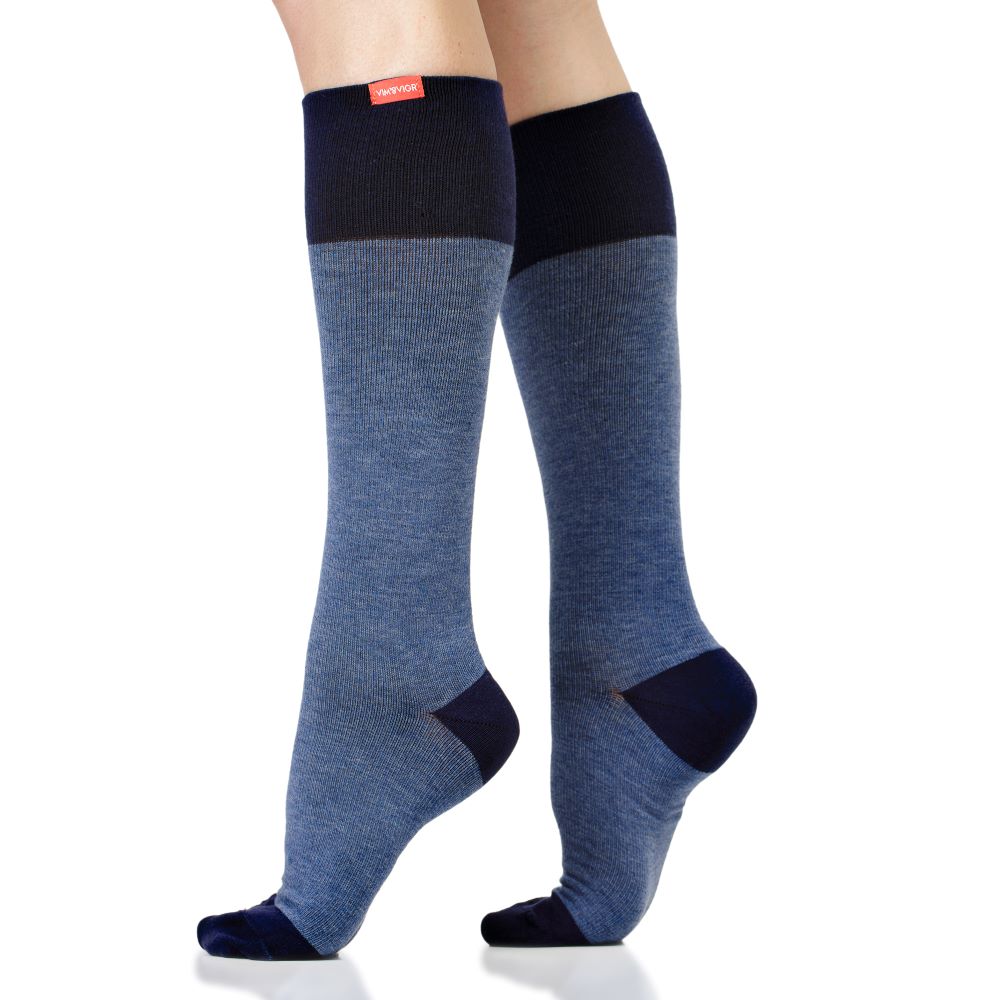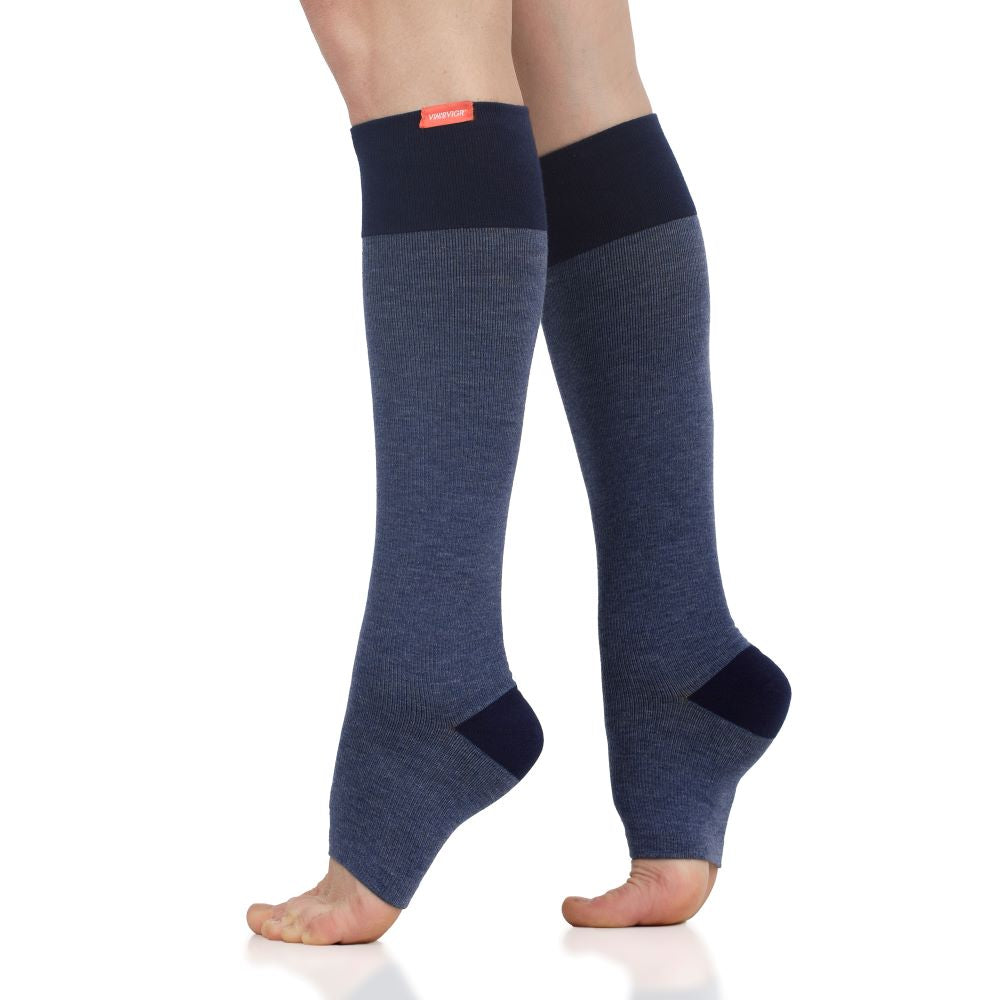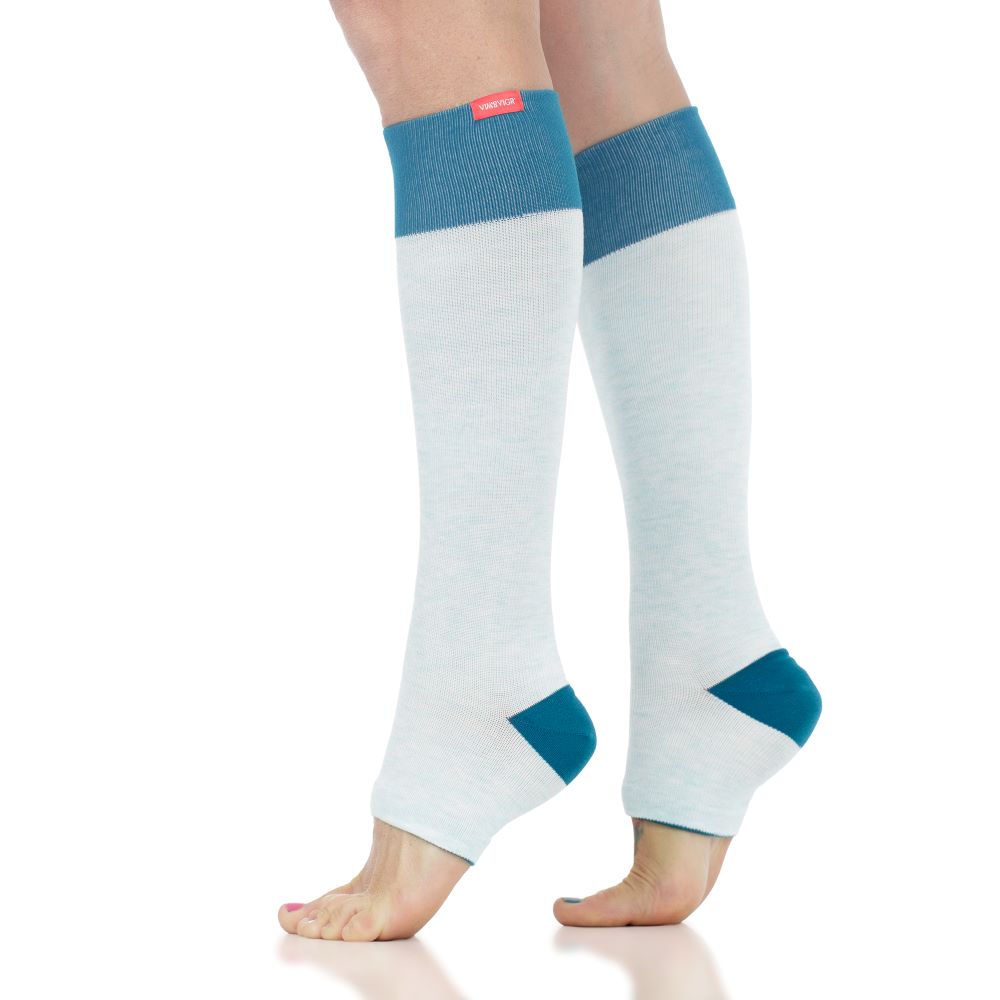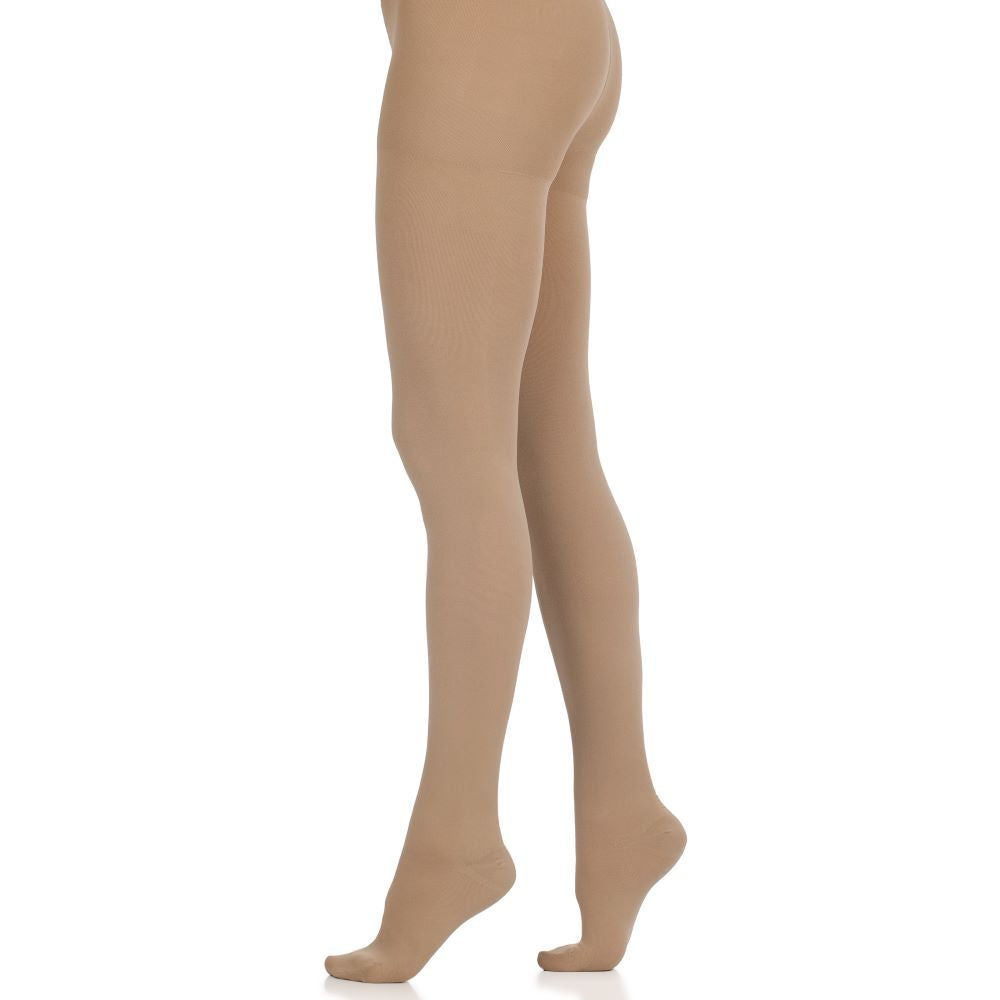
Compression Socks for POTS
Written By Alecsa Stewart
Scientifically Reviewed by Daniel Chantigian
Postural Orthostatic Tachycardia Syndrome, known as POTS for short, is a disorder of the autonomic nervous system that can cause dizziness, rapid increase in heart rate, and even fainting. POTS symptoms are most common when you stand up, but they can happen when you stand for a long time without moving. To manage POTS symptoms and ensure good blood flow throughout the body, compression socks and stockings may be a great solution for POTS patients.
The Benefits of Compression Socks for POTS
Compression socks are often prescribed to patients with POTS for how they stimulate blood flow from the lower limbs back to the heart. Medical studies have found that graduated compression socks and stockings boost circulation, help reduce swelling and inflammation, regulate blood flow and blood pressure when changing posture in people with POTS, and help you feel energized.
Enhancing Circulation
One of the main uses for compression socks is to improve leg circulation, especially in patients that have blood flow problems (e.g., varicose veins or a history of blood clots). The Vim & Vigr collection of compression socks and stockings supports healthy leg circulation, which is essential for people with heart or blood circulation problems (like people with POTS). Thanks to the graduated design of our compression garments, circulation is enhanced thanks to the garments being tighter at the ankles and looser towards the knees.
In addition to boosting blood flow back to the heart, compression socks support the veins and reduce the impacts of walking, standing, or sitting for long periods of time. For POTS patients, changing position from sitting to standing can cause dizziness and chest discomfort. By continuously supporting venous return and diminishing the impacts of sitting down for a long time, wearing compression socks can reduce the symptoms of POTS.
Reducing Swelling and Discomfort
A side effect of poor peripheral circulation, commonly encountered in individuals with POTS, is the swelling of the feet and ankles. One study found that people with POTS can have “low flow” of blood or constricted vessels in the extremities, which increases the risk of painful swelling. Wearing graduated compression socks helps reduce the risk of blood and lymph fluid pooling in the lower legs when sitting or standing for a long time. This contributes to lowering the risk of swelling, which is often associated with poor circulation.
Boosting Energy and Reducing Fatigue
By helping blood move more efficiently throughout the body and preventing it from pooling in the lower extremities, compression socks are great at helping you feel energized throughout the day. Minimizing swelling is also a contributor - how many times have you felt worn down by “heavy legs” and swollen ankles? Compression socks can help you treat fatigue from POTS by reducing pain, inflammation, and swelling in the legs.
Easing Symptoms During Changes In Position
For people with POTS, a change in position (like from sitting to standing) causes dizziness, lightheadedness, and a sudden drop in blood pressure. A 2019 study found that lower leg compression provided relief from POTS symptoms, maintaining better blood flow and pressure.
When to Wear Postural Orthostatic Tachycardia Syndrome Compression Stockings
POTS is a multifaceted condition, and many medical treatments have not been effective in treating it. A combined approach, using natural remedies such as wearing compression socks and watching your diet and hydration levels, can be effective in controlling the symptoms of POTS and improving your wellbeing. Here are our tips for maximizing the benefits of compression garments for POTS.
For Daily Symptom Management
Compression socks are one of the simplest and most reliable methods of countering POTS symptoms. Bonus: they are stylish, too! You can wear your favorite pair of cotton knee-high socks to work or while out and about, and enjoy the support they provide to your circulatory system and your lower leg muscles.
If you’re looking for more coverage, check out our range of compression tights and leggings for winter or for working out.
While Sitting or Standing for Long Periods
If you have POTS, one of the best uses of compression socks is wearing them when you must sit or stand for long stretches of time. Wearing compression socks will support circulation when you switch postures, making it less likely to experience a change of blood pressure or dizziness. Moreover, scientific reports found that wearing compression socks lowers the risk of blood clots or deep vein thrombosis on long flights, among other benefits.
During Exercise
When you work out, you may experience dizziness when moving from one position to another or engaging in more vigorous cardiovascular exercise. Unfortunately, a lack of exercise has been found to increase POTS symptoms, but dizziness during exercise makes it hard for people with POTS to exercise. So, how can you prevent POTS symptoms during exercise?
You may be able to prevent POTS symptoms during exercise by wearing socks designed for both stylish compression and support of physical activities. Moreover, knee-high compression socks support your muscles and tendons while also providing benefits to exercise performance and recovery.
For Recovery After a Long Day
Finally, how do you feel about a reinvigorating, soothing massage for your lower limbs after a long, stressful day? You can get all that simply by putting on a pair of high-quality Vim & Vigr compression socks! The therapeutic pressure applied to the legs gently massages the muscles, while stimulating upwards blood flow and relieving stress, tension, and fluid build-up.
For an even deeper relaxation, lift your legs up on a few cushions at the end of the couch as you relax. This can help improve circulation and bring down swelling and inflammation.
How to Choose the Best Compression Socks for POTS
Sold on the benefits of compression garments for POTS but not sure where to start? Here are some helpful tips on the things to look out for in your first pair of POTS compression socks.
Finding the Right Compression Level
Not all socks apply the same level of compression to the limbs. Here is a quick overview of the levels we offer at Vim & Vigr:
-
15-20 mmHg is the entry level for compression socks that are effective, yet gentle enough that they can be worn all day long, while exercising, or even sleeping.
-
20-30 mmHg socks offer tighter compression and more support. They are particularly useful for those who have medical conditions and often suggested by medical professionals.
-
30-40 mmHg socks are available only with a prescription - consult with your doctor if you feel that you need stronger compression or for specific needs linked to your health.
Exploring Fabric Options
Not only can you get the benefit of compression at different levels of therapeutic pressure, but you can also adjust them to your activity levels, environmental conditions, or general personal preference. At Vim & Vigr, we offer 4 different fabric types, each with their own properties:
-
Cotton for everyday wear, stylish looks and ongoing compression.
-
Merino wool for those cold days or nights, to keep feet warm and dry, or to help regulate air flow and keep feet cooler in the heat (yes, they work both ways!).
-
Nylon for a sleek, comfortable feeling when exercising.
-
Moisture wick nylon for dry, comfortable feet, no matter the conditions.
Getting the Right Fit
The last piece of the compression sock puzzle is fit. The right compression socks feel tight, but not uncomfortable, and you want to maintain flexibility and comfort levels while wearing them. This is why we recommend measuring the circumference of your calf, then matching that with our sizing chart to find the best option for you.
Remember that compression socks will feel different when you first wear them, so give your body time to adjust to the pressure. Start by wearing your socks 2-3 hours at a time, then gradually increase that time depending on how comfortable you feel. If you have any doubts or questions, always speak to a doctor.
References
van Campen, C. L. M. C., Rowe, P. C., & Visser, F. C. (2021). Compression Stockings Improve Cardiac Output and Cerebral Blood Flow during Tilt Testing in Myalgic Encephalomyelitis/Chronic Fatigue Syndrome (ME/CFS) Patients: A Randomized Crossover Trial. Medicina (Kaunas, Lithuania), 58(1), 51. Read it here.
Moñux, G., Serna-Soto, M., Plá-Sanchez, F., Zamorano-León, J. J., Segura, A., Rial, R., Freixer, G., Zekri-Nechar, K., Hugo-Martínez, C., Serrano, J., & López-Farré, A. (2021). Compression stockings attenuate the expression of proteins associated with vascular damage in human varicose veins. Journal of vascular surgery. Venous and lymphatic disorders, 9(2), 428–434. Read it here.
Bourne, K. M., Sheldon, R. S., Hall, J., Lloyd, M., Kogut, K., Sheikh, N., Jorge, J., Ng, J., Exner, D. V., Tyberg, J. V., & Raj, S. R. (2021). Compression Garment Reduces Orthostatic Tachycardia and Symptoms in Patients With Postural Orthostatic Tachycardia Syndrome. Journal of the American College of Cardiology, 77(3), 285–296. Read it here.
Charles, T., Mackintosh, D., Healy, B., Perrin, K., Weatherall, M., & Beasley, R. (2011). Merino wool graduated compression stocking increases lower limb venous blood flow: a randomized controlled trial. Advances in therapy, 28(3), 227–237. Read it here.
Kelly, K. L., Johnson, C. P., Dunne, L. E., Holschuh, B., Joyner, M., & Johnson, B. D. (2019). Active compression garment prevents tilt-induced orthostatic tachycardia in humans. Physiological reports, 7(7), e14050. Read it here.
Clarke, M. J., Broderick, C., Hopewell, S., Juszczak, E., & Eisinga, A. (2021). Compression stockings for preventing deep vein thrombosis in airline passengers. The Cochrane database of systematic reviews, 4(4), CD004002. Read it here.
Fu, Q., & Levine, B. D. (2018). Exercise and non-pharmacological treatment of POTS. Autonomic neuroscience : basic & clinical, 215, 20–27. Read it here.

















